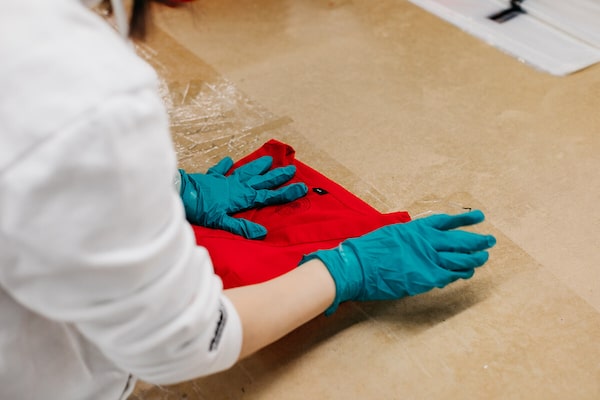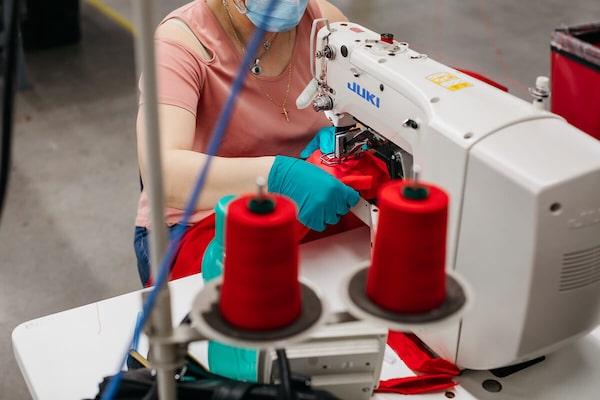
Kingi Carpenter had just launched a new studio called Peach Berserk on Toronto’s Queen Street West when the pandemic struck. Now, her specialty fashion shop is churning out unique hand-printed masks, such as the one modelled by her daughter Digby Jade Finkel, at left. The $20 masks are all made to order and can be completely customized.PHOTOS COURTESY OF PEACH BERSERK
Kingi Carpenter threw an opening-night party for her new studio and workshop space on Toronto’s Queen Street West – the night before the city went into a COVID-19 lockdown. The timing couldn’t have been worse for the owner of Peach Berserk.
Carpenter, who creates upcycled fashion overprinted with silkscreens, had poured everything into her new space. As she shuttered her doors, she worried about how she was going to make next month’s rent.
Now she’s working 11-hour days, including weekends, and even hired staff, thanks to the popularity of her silkscreened non-medical-grade face masks. It’s all the more surprising to her because she “did this kind of on a lark.”
Two weeks into shelter-in-place orders, Carpenter made a few masks and posted photos on social media.
“Within half an hour an order came in,” Carpenter says. “Five minutes later another order and another order. Have I gone into the Twilight Zone?”
Now she’s getting hundreds of orders a day for her $20 masks, each hand-printed to order. “Orders come in night and day,” she says. “It has been overwhelming.”
Carpenter is part of a growing community of international and hyper-local designers switching gears to make personal protective equipment (PPE) for consumers and frontline health-care workers, helping to protect against the spread of COVID-19.
Peach Berserk, for example, offers a selection of silkscreened prints, from a David Bowie headshot to a lip smack to a “limited edition kitty kat on leopard with hot pink.” But customers can pay extra for their own custom designs, such as a photograph of their dog. Heavy metal bands have also turned out to be a popular option.
“If there’s one thing about the human race, it’s that we’re adaptable, vacuums get filled. There are so many little businesses that have popped up, it’s really amazing,” Carpenter says. “Not since the ’90s have people appreciated sewing and made-in-Toronto production like they do right now.”

PHOTOS COURTESY OF CANADA GOOSE
These days, even Chanel is creating mask prototypes. And Canada’s design labels, big and small, are heeding the call.
Toronto-based Ellie Mae, for example, is making non-medical-grade face masks in 13 styles, including three with sequins in pink, teal or navy. Each costs $20, with $5 from each mask donated to Feed The Frontlines TO. Canadian evening-wear brand Narces is making PPE as well, with five masks available in black, gold, silver, hounds-tooth and floral.
Toronto designer Hilary MacMillan is producing 100 non-medical-grade masks a week using upcycled materials and donating them to frontline workers at shelters, grocery stores and retirement homes. Quebec-based brand SHAN is making medical-grade protection equipment for consumers, including waterproof protective gowns.
Some of the country’s larger brands with Canadian manufacturing facilities are switching gears to make medical-grade PPE for health-care workers, helping to deal with massive shortages of such PPE as gowns and scrubs.
“Pretty early on, we were talking to people at hospitals and health-care facilities and learned that there was an urgent need for PPE and other gear like scrubs,” says Dani Reiss, chief executive officer of luxury outerwear brand Canada Goose. “They knew there would be massive shortages as the virus spread, and we knew we could help.”
Canada Goose has built one of the largest apparel manufacturing infrastructures in Canada. As a result, it was able to quickly re-tool its facilities to produce a variety of PPE, including gowns and scrubs, at scale.
“In facing a situation like this where the entire world is in crisis and lives are on the line, using whatever resources we had to help protect people who are risking their lives every day was just the right thing to do,” Reiss says.
Now, with provincial and federal government contracts in place, they’re making at least 60,000 Level 2 medical gowns every week for the foreseeable future, with the capacity to grow that number up to 100,000 units per week. By shifting to PPE, Canada Goose has also been able to reopen all eight of its production facilities and bring hundreds of employees safely back to work.

Canada Goose was able to adapt its manufacturing facilities to produce tens of thousands of medical gowns and scrubs every week.PHOTOS COURTESY OF CANADA GOOSE
All PPE production is being done at cost. Any unintentional profits, potentially derived from efficiencies, will be donated to COVID-19 relief funds. “For me, this is about doing what’s right, not about profit,” Reiss says.
Arc’teryx, an outdoor apparel company, also responded to the call, which came directly from local health authorities in British Columbia. After 10 days of collaborating with local manufacturing and design partners, Arc’teryx came up with a prototype for a reusable medical gown to address the current shortage.
There are different types of gowns – from surgical gowns to isolation gowns – and protection ranges from levels one to four. Arc’teryx is well-suited to making PPE, since it designs highly technical outdoor apparel known for its water resistance, breathability and comfort.
“We’re very familiar with water resistance, albeit it’s about rain and snow,” says Shirley Chan, senior director of product commercialization and quality with Arc’teryx. “So it wasn’t something that was unknown to us. [It was a matter of] just reimagining it for a different user and finding something that would work.”
Arc’teryx is currently in production to manufacture 30,000 medical gowns for a total of 90,000 alongside its partners Mustang Survival and Boardroom Clothing. The pattern, design and technical specifications of the gown have also been made publicly available to manufacturers around the world.
“If we’re able to contribute to this effort in any way, we’re hopeful we’ll recover faster,” Chan says. “If there’s anything that really resonates, it’s how fast locals banded together.”
For Reiss, “this is arguably the most important work we will do,” he says. “And for me personally, knowing we are doing what’s needed in such a difficult time gives me a new reason to wake up in the morning.”
Advertising feature produced by Globe Content Studio. The Globe’s editorial department was not involved.